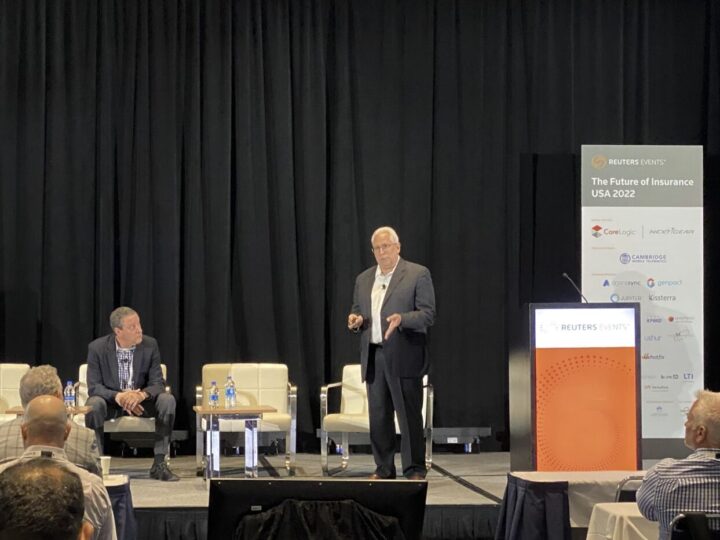 The insurance industry is going through an intense period of change – one that requires insurers to be nimble and move fast in order to meet the challenge of both new consumer expectations and new patterns that reshape the context in which they operate. To enable the flexibility and speed necessary to remain competitive, leading insurers are embracing change and adopting innovative technologies to build a digital core that will support future growth.
The insurance industry is going through an intense period of change – one that requires insurers to be nimble and move fast in order to meet the challenge of both new consumer expectations and new patterns that reshape the context in which they operate. To enable the flexibility and speed necessary to remain competitive, leading insurers are embracing change and adopting innovative technologies to build a digital core that will support future growth.
At the recent Reuters Events: The Future of Insurance USA 2022 conference in Chicago (where ValueMomentum was a gold sponsor), insurance executives at leading carriers, insurtechs, and vendors gathered to discuss the latest challenges facing the industry, share innovative tools and strategies to prepare for the future, and gather insights to help them develop their own digital foundation.
Managing Risks Now and in the Future: Automation and Digital Tools
An overarching theme present in the many presentations at the conference was the emergence of new risks to the business. With current events like supply chain disruptions, inflation, climate change, and cybercrimes impacting the business environment, insurers in attendance acknowledged that they must take these factors, as well as new threats that will arise in the future, into account.
As insurance leaders discuss the transformation journeys they are on – journeys to improve customer experience, expand digital distribution, customize product offerings, and optimize processes and operations—embracing innovative technological solutions to adapt to the rapidly changing business environment is a common strategy. In fact, making better use of automation and digital tools is a goal shared by all insurers. The challenges brought on by the global pandemic have accelerated the realization of how these technologies can be leveraged; businesses are recognizing the potential inherent in such solutions to expedite outcomes and foster better customer relationships.
Nationwide’s CTO emphasized the role of technology in his presentation and took it a step further by discussing how technology can be humanized to drive these business outcomes. Examples he shared included: using AI like an advisor to prompt suggestions on what customers need at different stages of their lives; leveraging virtual assistants to enhance and simplify the claims process; allowing claims adjusters to focus on customer service; and enabling small business owners to operate more efficiently by providing them with embedded insurance through an ecosystem of partners.
Overcoming Impediments to Transformation is the Primary Goal
But even with the strategy to embrace advanced technologies and move fast, insurers still are faced with overcoming impediments to innovation. These impediments center around legacy architecture, a risk-averse culture that doesn’t allow for exploration and experimentation, and a shortage of skilled talent.
Insurers acknowledged that being saddled with legacy systems in this competitive space is a recipe for failure. They recognized that those who embrace modern systems will have the capability to achieve integration and automation to deliver on today’s customer expectations. To this end, many if not all insurers have gone through, or are going through, core modernizations.
To address the challenge of talent, insurers discussed a variety of measures and programs that are needed to attract and engage talent in this competitive talent market and the need to work with partners to access the necessary resources.
The culture challenge is the hardest to tackle, simply because there is no clear-cut solution. Executives speaking on this topic offered general suggestions that included embracing transformation as a value for the business and IT, and setting the tone for the entire company to allow for exploration and experimentation that reimagines processes in a way that not only meets today’s needs, but prepares the company for tomorrow’s challenges.
Digital Core as the Foundation for Future Growth
 Hand-in-hand with the goal to overcome impediments is the goal to drive speed. In the Innovation track, ValueMomentum’s EVP of Insurance, James Carlucci, and RLI’s CIO, Bryan Fowler teamed up to speak about “Innovation: The Need for Speed.”
Hand-in-hand with the goal to overcome impediments is the goal to drive speed. In the Innovation track, ValueMomentum’s EVP of Insurance, James Carlucci, and RLI’s CIO, Bryan Fowler teamed up to speak about “Innovation: The Need for Speed.”
As Carlucci pointed out, today’s customers expect engaging and seamless experiences. They want access to insurance products and services from where they are, through their channel of choice. To deliver on customers’ expectations, ValueMomentum is seeing insurance clients build out a unified platform, or a digital core, to provide highly tailored solutions to customer segments through varied forms of digital touchpoints. This digital core will require multiple discrete technologies and substantial investment. Building a digital core entails several transformation journeys, including: digital and cloud transformation, core transformation, a modern data platform, infrastructure and application modernization, and business assurance transformation.
With this digital foundation in place, insurers can quickly enter new markets, seamlessly integrate with partners to expand their ecosystem, digitize operations to lower costs, and engage and delight customers to reduce churn, among other benefits. Although the process of building a digital core can be long and complex, having this digital foundation will position the insurer to handle new challenges on the horizon.
Fowler expanded on Carlucci’s call for a digital core by sharing RLI’s journey to developing its digital foundation. He shared that RLI has been investing in technology to leverage distribution and increase efficiency. The digital foundation RLI built leveraged an innovative design that includes:
- open-sourced technologies
- modular architecture
- multi-vendor cloud
- quick and secure connections to partners
- new product and distribution concepts
- digital access
- customizable experiences for customers
This design allows for flexibility and enables the company to move quickly—an important business goal. The flexibility baked into the system will allow for it to accommodate additional functionality in the future, which is key to RLI’s long term strategy for technological innovation.
Fowler admitted that achieving innovation can be a major challenge for the insurance industry, especially for the firms whose progress is impeded by legacy systems and processes. He recommended looking to successful companies in other industries – Airbnb, Uber, and Starbucks – for inspiration on how to effectively leverage data and technology to build up social capital (one of the metrics of innovative success).
Similar to other presenters, Fowler urged all attendees to think not in terms of the tools, but the mindset that underlies the innovative progress. This includes allowing for exploration and the failures along the way, which are an inevitable part of moving away from the way things have always been done to try out new approaches.
The Future of Insurance: Embracing Change and Driving Innovation
The foundation for the future of insurance is being built now by innovation leaders who embrace change and prepare for adaption. As presenters and attendees alike acknowledge: overcoming impediments to technological advancements is required; recognizing and addressing new and emerging risks is important; and capitalizing on automation and digital tools for distribution can be a game changer.
Those who fail to adopt the transformative capabilities and the customer-centric model for business will inevitably lose their customers to the companies that are doing it right now. The insurers who are not only investing in digital cores now, but are fostering a culture of innovation that will enable them to adapt and evolve to meet all future challenges, are the ones who will thrive.
To learn more about how you can position your business to deliver new experiences to stay competitive in today’s customer-centric market, check out ValueMomentum’s Digital & Cloud Solutions.
